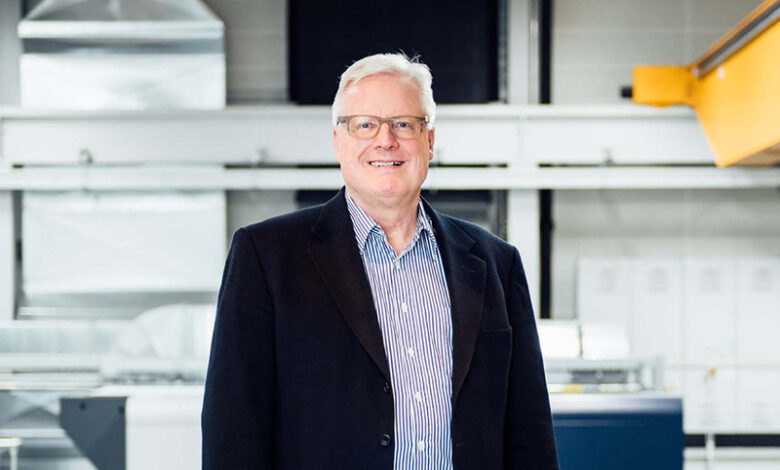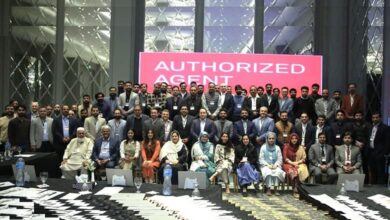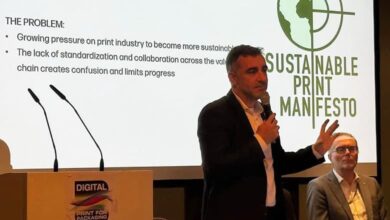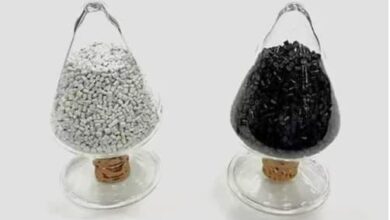“Sustainability is a Top Priority at Koenig & Bauer”

Dr. Andreas Pleßke, new CEO of Koenig & Bauer AG, explains why sustainability is of such high strategic importance and how it is being pushed by financial markets and the more environmentally aware youth.
Source: VDMA
In its “Circular Competence” interview series, the VDMA Printing and Paper Technology Association asks its member companies about their plans, solutions and challenges on the road to a circular economy. What can the industry do to help minimize the environmental footprint of packaging and other printed products?
Sustainability is a top priority at Koenig & Bauer AG. In an interview, the press manufacturer’s new CEO, Dr. Andreas Pleßke, explains why the topic is of such high strategic importance and how it is being pushed by financial markets and the more environmentally aware youth.
Dr. Pleßke, as the new CEO of Koenig & Bauer AG, you have also taken over as Head of Sustainability. Why?
We had already dealt with this topic in detail beforehand. But when we reassigned responsibilities at the beginning of 2021, we took a close look at the future strategic direction of our business model. In the process, we identified sustainability as a key issue. We are setting up a new, Group-wide department with good staffing and are also strengthening our communications. The issue of sustainability is moving into a new weight class. It is about decency in dealing with the environment and natural resources. In addition, the boundary conditions have changed. Sustainability is increasingly present in social discourse, regulatory requirements are increasing with the European Green Deal – and from a recent trip to the USA, I got the impression that our customers there have a clear expectation of us to support them in making their production more environmentally compatible.
Did they give any reasons for this?
On the one hand, they explain that the capital market is increasingly scrutinizing whether investments are sustainable and therefore fit for the future as part of risk management. Genuine efforts to ensure sustainable processes are thus becoming a success criterion for financing. But our U.S. customers, who work exclusively with equity, are also giving sustainability top priority, pointing to the change in awareness among the younger generation, who use social media to find out exactly what is going on. I have heard in many conversations that the success of a product in the future will stand or fall on how sustainably it is packaged. The trend is clear: more renewable raw materials and more recycling. The packaging discussion will play an even greater role. We are well advised to prepare for this by trimming our machines and processes for maximum resource efficiency. This is the only way we can meet and ideally exceed clear customer expectations.
The United Nations warns of a global trend to the contrary: by 2050, the demand for resources threatens to double. What are you doing about this in your own production?
Energy consumption leaves the biggest footprint, especially since Koenig & Bauer operates its own foundry. There, we invest in modern energy-efficient furnaces to reduce CO2 emissions. We light our halls with LEDs. We are currently investigating our own sustainable power supply with photovoltaic systems or a combined heat and power plant. Our metal processing department has established a maximum level of recycling – if only for cost reasons. We also separate all other operating materials by type and recycle them wherever possible.
Your products offer the greater leverage for resource conservation. How sustainable is your printing technology?
It starts with the fact that our presses can run 24/7, 365 days a year. The better a press is utilized and the less often it has to be ramped up to process speed after restarts, the lower the energy and resource requirements. The market trend towards smaller print jobs with constant restarts is rather counterproductive. We compensate for this, at least in part, through more efficient drive technology, regular maintenance and targeted training for press operators. More important is the use of materials. With the exception of textiles, our machines print on almost all substrates: paper, cardboard, corrugated board, glass, metal, plastics, and films made of natural, synthetic, and composite materials. Our processes have a major influence on their consumption. On average, a typical medium-format offset sheetfed press in packaging printing prints almost 9,000 tons of paper with 500 tons of ink every year – a single press, mind you. If we increase its efficiency by just a few percent, the leverage effect is enormous. We are becoming increasingly successful in minimizing startup waste, which brings major savings because of the large number of job changes. We are also pushing ahead with solutions to achieve top quality with reduced ink consumption. And the fact that our presses almost exclusively use water-based, food-grade coatings reduces the electricity required for drying by 30 percent – especially since our drying processes use hot air twice.
That sounds like intensive research and development for greater resource efficiency.
This has been the driving issue for a long time. For our banknote printing presses, for example, which need part heat supply and part cooling in the process, we have implemented a thermoregulation system that intelligently links heating and cooling. If our customers in this market alone were to implement this Power Safe solution consistently, it would save 45,000 metric tons of CO2 per year. A further 10,000 metric tons could be achieved through the consistent use of UV LEDs. The fact that I can give you these figures is, incidentally, a first consequence of the EU’s new taxonomy rules. We now have to look more closely at what happens to our machines at the customer’s site.
To what extent do you coordinate your R&D topics with user industries?
We have set up a strategy process that involves not only our direct customers but also global brand owners and packaging manufacturers with whom we do not work directly. In discussions, we discuss their views on the megatrends in the packaging market. Based on this, our new strategy “Exceeding Print” is built on three pillars: Sustainability, Modularity, Digitalization. Our engineering is geared towards providing our customers with optimum support in achieving their sustainability goals. To this end, we are establishing closed control loops in the interaction of inspection in the printing process and AI-optimized control and color saturation, which readjust themselves in the process. The better we succeed in modularizing such solutions, the faster we can bring them to the markets. It is not only our customers in the USA who are demanding resource-efficient, sustainable solutions: The global printing and packaging industry is taking up the social challenge – and is now increasingly investing in sustainable solutions.
Should legislators additionally promote resource-efficient technologies?
Two hearts beat in my chest: Politicians naturally lack deep technical insight into the markets. They should therefore – if at all – promote and regulate in a way that is open to technology. I am also speaking out of self-interest here, because Koenig & Bauer covers almost all substrates and process steps. If there were any intervention, it would almost certainly affect us at one point or another. The other heart recognizes that it can also have a positive influence on the markets if politicians agree on clear framework conditions and promote efficiency in a way that is open to technology. In retrospect, the much-criticized EU emissions legislation has proven to be a successful model. But it is extremely complicated and burdensome for globally active companies if different framework conditions have to be met in different markets. This drives up costs in our already very cost-sensitive industry. The bottom line is that we need a sense of proportion and the greatest possible harmonization.





